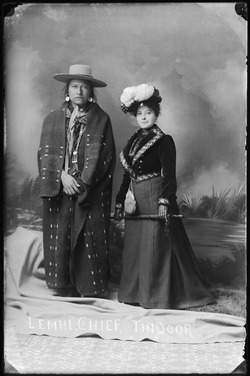Lemhi Shoshone facts for kids
 |
|
| Total population | |
|---|---|
| Fewer than 5,300 | |
| Regions with significant populations | |
| Languages | |
| Shoshone, English | |
| Religion | |
| Native American Church, Sun Dance, traditional tribal religion, Christianity, Ghost Dance |
|
| Related ethnic groups | |
| other Shoshone tribes, Bannock, Northern Paiute |
The Lemhi Shoshone are a group of Northern Shoshone people. They are also known as the Akaitikka or "Eaters of Salmon." The name "Lemhi" comes from Fort Lemhi, which was a mission built by Mormons near their lands.
These people traditionally lived in the Lemhi River Valley. They also lived along the upper Salmon River in Idaho. The Lemhi Shoshone were nomadic, meaning they moved around a lot. They often joined with and married people from other Shoshone groups and tribes like the Bannock. Today, most Lemhi Shoshone are part of the Shoshone-Bannock Tribes in Idaho.
What Was Traditional Lemhi Shoshone Life Like?
The Akaitikka people speak the Shoshone language. This language is part of the Numic language family.
Fishing was a very important way to get food. Salmon and trout were main foods for them. They also ate plants like gooseberries and camas root. Camas root is a plant called Camassia quamash. In the 1800s, hunting buffalo was also important. Buffalo provided meat, furs, and hides for many uses.
Key Moments in Lemhi Shoshone History
During the 1800s, the Lemhi Shoshone were friends with the Flatheads. They were enemies of the Blackfeet tribe.
The famous Lewis and Clark Expedition met the Lemhi Shoshone in 1805. This meeting happened at the Three Forks of the Missouri River. In the 1860s, government agents thought there were about 1,200 Lemhi people. This number included Shoshone, Bannock, and Tukudeka (Sheepeaters) people.
Tendoy was a very important Lemhi chief in the mid-1800s. He was half-Shoshone and half-Bannock. Tendoy became the main chief of the Lemhi in 1863. This happened after the previous chief, Tio-van-du-ah, was killed.
The Lemhi Reservation was created in 1875. It was located along the Lemhi River in Idaho. However, this reservation was closed in 1907. Most of the people living there were moved to the Fort Hall Indian Reservation. Some Lemhi Shoshone still live near Salmon, Idaho, today.
A person named Robert Harry Lowie studied the Lemhi Shoshone. He wrote a book about them called The Northern Shoshone in 1909.
Important Lemhi Shoshone People

